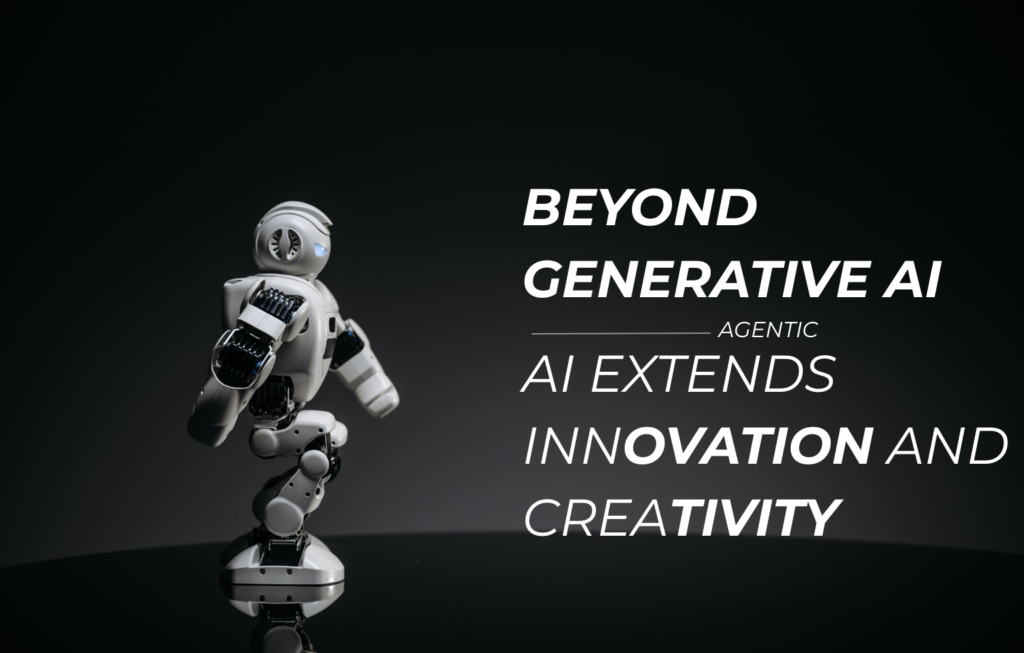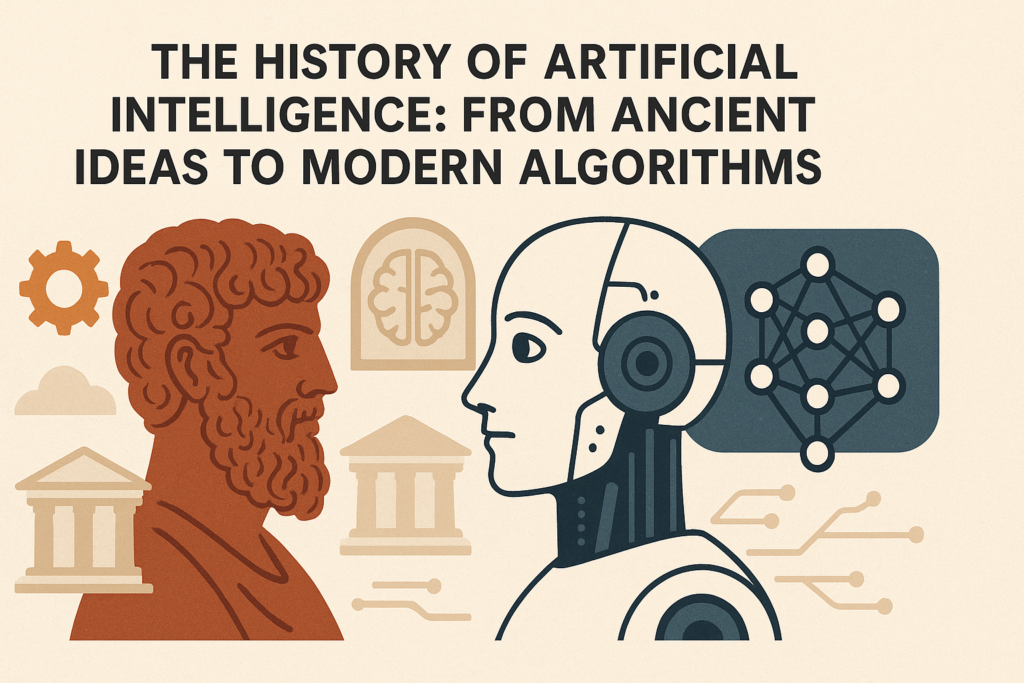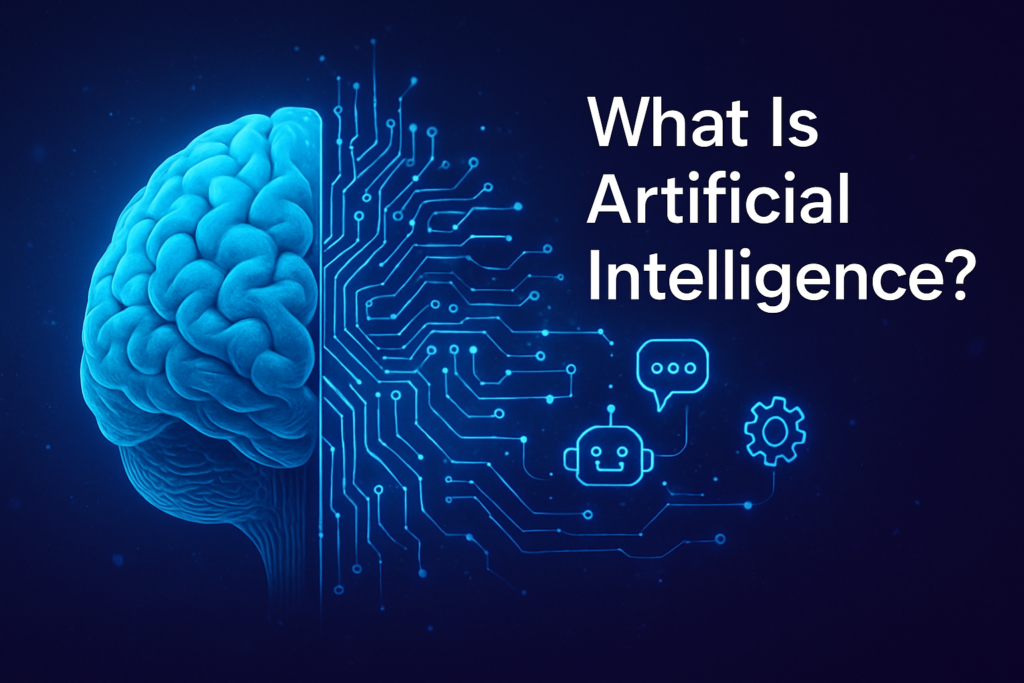Contents
- Beyond Generative AI: Agentic AI Extends Innovation and Creativity
- The Shift Beyond Generative AI
- What Is Agentic AI?
- How Agentic AI Works: Inside the Mechanism
- Generative AI vs. Agentic AI: What Sets Them Apart
- Real-World Use Cases Today
- The Strategic Role of Agentic AI in the Enterprise
- The Infrastructure Challenge
- From Digital to Physical: AI Meets the Real World
- Safety, Ethics, and Trust in Agentic AI
- Future Outlook: Where Agentic AI Is Heading
- Conclusion: A Call to Explore Agentic AI
Beyond Generative AI: Agentic AI Extends Innovation and Creativity
The Shift Beyond Generative AI
The rapid rise of generative AI—led by platforms like ChatGPT—has fundamentally reshaped how we create content, communicate, and automate knowledge work. In just a few short years, it has empowered individuals and organizations to produce text, code, images, and more with unprecedented ease and scale. Yet, as businesses become increasingly familiar with its capabilities, a new frontier in artificial intelligence has begun to emerge: Agentic AI.
Agentic AI represents the next major leap—moving beyond content generation into autonomous action and decision-making. Unlike generative AI, which responds based on prompts, agentic AI can independently interact with environments, execute multi-step tasks, and learn from outcomes. It acts with purpose, adapts through feedback, and collaborates with other AI agents.
This marks a transformative shift in AI evolution. Agentic AI has the power to extend human creativity and intelligence far beyond passive automation—unlocking new realms of innovation, operational efficiency, and strategic value.
What Is Agentic AI?
Agentic AI is an advanced form of artificial intelligence that goes beyond generating content or responding to queries—it’s capable of autonomous action, decision-making, and learning through real-time interaction with its environment. Unlike generative AI, which produces outputs like text, images, or code based on user prompts, agentic AI can initiate tasks, respond dynamically to changing conditions, and execute decisions across systems without ongoing human input.
In the five-stage roadmap of AI development, agentic AI occupies Stage 3—a critical midpoint between conversational AI (Stage 1) and reasoning AI (Stage 2), and the future stages of fully innovative and organizational AI (Stages 4 and 5). This stage marks a pivotal transition from reactive tools to proactive systems.
At its core, agentic AI is defined by:
- Autonomous decision-making: it can assess context, choose the best action, and execute without human prompts.
- Feedback-driven learning: it refines its behavior based on outcomes and environmental input.
- Multi-agent collaboration: different AI agents can assume specialized roles and work together in coordinated, role-playing dynamics to solve complex problems.
This evolution sets the stage for AI systems that not only assist but act—reshaping how work is done, decisions are made, and innovation unfolds.
How Agentic AI Works: Inside the Mechanism
Agentic AI operates at the intersection of intelligence and autonomy, powered largely by large language models (LLMs) that function as advanced reasoning engines. These LLMs don’t just interpret input—they actively process complex logic, make decisions, and initiate actions. Unlike generative AI, which responds to prompts, agentic AI is capable of pursuing goals, executing commands, and iterating based on outcomes.
One of the key enablers of agentic AI is its integration with external tools via APIs. Through these APIs, an agentic system can interface with calendars, databases, CRMs, content management platforms, design tools, and much more—executing real-world tasks like scheduling meetings, publishing content, or initiating business processes without human intervention.
Traditional reinforcement learning often requires agents to start from scratch, gradually improving through trial and error. In contrast, agentic AI begins with a pre-trained foundation of language and reasoning capabilities, allowing it to skip much of the early inefficiency and immediately take action with a baseline of intelligence.
When tackling complex problems, agentic AI can deploy multiple specialized agents—each assigned a specific role or area of focus. These agents collaborate in a “role-playing” framework, exchanging knowledge and iterating toward a shared goal, enhancing the system’s precision and effectiveness.
Crucially, agentic AI systems can interact dynamically with environments, receiving feedback and adjusting behavior in real time. This makes them ideal for scenarios where conditions constantly evolve, such as supply chain management, cybersecurity, and customer service.
In essence, agentic AI doesn’t just follow instructions—it learns, adapts, and acts independently, making it a transformative leap in AI evolution.
Generative AI vs. Agentic AI: What Sets Them Apart
Generative AI, like ChatGPT, is designed to create content—text, images, music, or code—based on prompts. It’s like a highly skilled content writer that generates ideas on demand. While powerful for creativity, it typically requires human direction and manual follow-through.
Agentic AI, on the other hand, is more like an operations manager. It not only generates responses but makes decisions, takes actions, learns from feedback, and adapts to achieve specific outcomes. It can operate autonomously across systems, from scheduling meetings to managing workflows, all with minimal human input.
These two forms of AI complement each other. Generative AI provides the creative and linguistic capabilities, while agentic AI builds on that foundation to execute real-world tasks. Together, they form a seamless system that’s both intelligent and action-oriented—where content creation leads to tangible outcomes, enabling end-to-end automation and innovation at scale.
Real-World Use Cases Today
Agentic AI is no longer a futuristic concept—it’s already reshaping core business operations across industries. Its autonomous decision-making and adaptive capabilities make it ideal for tackling complex, time-sensitive, and high-volume tasks.
Supply Chain Optimization
In logistics and procurement, agentic AI has transformed supply chain responsiveness. What used to take weeks to process purchase orders can now be handled in minutes. These intelligent systems track inventory levels, analyze demand patterns, communicate with suppliers via APIs, and issue orders—all autonomously. This streamlines operations, reduces stockouts, and improves customer satisfaction.
HR Automation
Agentic AI enhances HR functions by automating repetitive processes such as employee onboarding, task assignment, and document generation. Instead of manual routing, AI agents read forms, update databases, schedule meetings, and send welcome packets—creating a smoother and faster onboarding experience.
Data Retrieval & Workflow Assistance
Agentic AI also excels in process acceleration. By integrating with enterprise systems, it retrieves relevant data, pre-fills forms, and routes approvals—cutting through red tape. Whether it’s invoice processing or internal compliance checks, the AI navigates workflows with minimal human intervention.
Cybersecurity Operations
Agentic AI acts as a real-time defense agent. It monitors systems, flags anomalies, initiates countermeasures, and automates recovery protocols to minimize downtime. The result is a proactive cybersecurity posture that protects data and maintains continuity.
Predictive Maintenance
In manufacturing and infrastructure sectors, agentic AI analyzes sensor data to predict machine failures, schedule preventive maintenance, and optimize repair cycles—reducing downtime and extending equipment lifespan.
Software Development
FPT’s CodeVista is a standout example. This agentic AI platform delivers a 48% productivity boost by offering intelligent code suggestions, recognizing structural patterns, and maintaining high coding standards. Developers are freed from repetitive syntax tasks and can focus on creative problem-solving.
These applications highlight how agentic AI is not just a tool—it’s a transformative co-pilot across critical business functions.
The Strategic Role of Agentic AI in the Enterprise
Agentic AI is poised to become a strategic asset for modern enterprises by reshaping the way work gets done. Rather than simply replacing human effort, it elevates employee roles by taking over time-consuming, repetitive, and rule-based tasks. This shift allows employees to redirect their energy toward higher-value activities such as creative thinking, strategic planning, and innovation.
In practice, this means marketers can spend less time on campaign logistics and more on big-picture storytelling. Analysts can focus on drawing insights rather than compiling reports. HR teams can prioritize employee engagement while agentic systems handle administrative workflows.
The result is a measurable boost in productivity, decision-making speed, and job satisfaction. Employees feel empowered, not replaced, as they are supported by intelligent systems that reduce cognitive load and streamline workflows.
Crucially, agentic AI impacts both the front-end and back-end of the enterprise. On the customer side, it enhances personalization, response time, and experience. On the operational side, it improves efficiency, reduces errors, and enables round-the-clock responsiveness.
By automating complexity and enabling intelligent delegation, agentic AI isn’t just a support system—it’s a strategic enabler that makes the modern enterprise smarter, faster, and more resilient in a highly competitive landscape.
The Infrastructure Challenge
The rise of agentic AI brings with it a new era of infrastructure demands. Unlike traditional AI models, agentic systems require significantly more computational power, especially when multiple AI agents work together, reason, act, and learn in real-time. To support this, enterprises must invest in high-performance GPUs and scalable compute resources capable of handling vast data inputs, complex decision paths, and multi-agent interactions.
However, the future of agentic AI also lies in lightweight, domain-specific models that can operate on edge devices—delivering intelligence closer to the source of action, like in smart factories, autonomous vehicles, or handheld devices. These systems will rely on custom AI-optimized silicon, such as application-specific integrated circuits (ASICs) and neural processing units (NPUs), to maximize efficiency while minimizing energy consumption.
Another critical piece of the infrastructure puzzle is data handling. Agentic AI depends on fast and reliable access to massive volumes of data. To meet these demands, enterprises will need in-memory computing architectures and advanced interconnect technologies that ensure seamless communication between processing units and memory banks.
In short, for agentic AI to scale effectively and reliably, enterprises must rethink infrastructure from the ground up—optimizing for speed, adaptability, and intelligent autonomy.
From Digital to Physical: AI Meets the Real World
While Agentic AI currently leads the charge in digital transformation, its impact is rapidly expanding into the physical world. Beyond automating workflows and data processing, agentic systems are beginning to drive real-world actions through integration with robotics and IoT.
One prominent example is in warehouse management, where autonomous agents optimize inventory movement, assign tasks to robots, and adjust operations based on real-time data. Similarly, drone fleets powered by Agentic AI are being deployed for environmental monitoring, delivery logistics, and infrastructure inspection—navigating dynamic environments and learning from each mission.
These applications mark the convergence of AI and autonomous systems, with Agentic AI acting as the critical bridge. Its ability to reason, adapt, and act enables machines to move beyond pre-programmed responses into intelligent decision-making in complex physical settings. This shift represents a new frontier where digital intelligence reshapes how machines operate in the real world.
Safety, Ethics, and Trust in Agentic AI
As Agentic AI becomes more autonomous and embedded in decision-making, it raises critical concerns around safety, ethics, and trust. One of the foremost challenges is bias—AI agents trained on historical or unbalanced data may unintentionally reinforce existing inequalities. Similarly, privacy risks escalate as agentic systems handle sensitive personal and enterprise data while interacting with multiple tools and APIs.
A unique concern with Agentic AI is emergent behavior—unexpected actions that arise when autonomous systems interact in complex environments. These outcomes may not be easily predicted or explained, making transparency and explainability in decision-making essential. Enterprises and users must understand how AI agents reach conclusions and take action, especially when those actions carry significant consequences.
To maintain a productive human-AI collaboration, organizations must establish clear boundaries between agent autonomy and human oversight. This includes audit trails, approval checkpoints, and real-time monitoring dashboards to keep human operators in the loop.
Establishing ethical frameworks and aligning with evolving AI regulations—such as the EU AI Act or industry-specific guidelines—is crucial for sustainable deployment. These frameworks should promote fairness, accountability, and transparency from development through deployment.
Ultimately, building trust in Agentic AI will depend on secure, well-governed deployments. Enterprises must invest in robust cybersecurity, data governance, and training programs to ensure ethical use. When developed responsibly, Agentic AI has the potential to become a trusted partner—augmenting human capabilities, driving innovation, and operating with integrity in complex environments.
Future Outlook: Where Agentic AI Is Heading
Agentic AI is poised to become deeply embedded in business operations, scaling innovation pipelines and accelerating decision-making across industries. Rather than replacing humans, it will serve as a powerful augmentation tool, handling complex, repetitive tasks so people can focus on strategic and creative work.
We can expect tighter integration with generative AI, robotics, and the Internet of Things (IoT), enabling autonomous systems that operate seamlessly across both digital and physical environments. For example, agentic AI-powered robots could manage warehouses or perform precision maintenance, while AI agents optimize supply chains and customer interactions in real time.
Over the long term, Agentic AI promises a societal transformation by enhancing productivity, resilience, and innovation on an unprecedented scale. As businesses and governments adopt these technologies, new opportunities will arise for smarter infrastructure, personalized services, and more sustainable operations—reshaping how we live and work in the decades to come.
Conclusion: A Call to Explore Agentic AI
Agentic AI represents a leap beyond simple automation into autonomous intelligence that can learn, adapt, and make complex decisions. While challenges like ethics, safety, and infrastructure remain, the opportunities it offers for innovation, efficiency, and competitive advantage are immense. Businesses that begin to explore and pilot agentic AI solutions early will position themselves at the forefront of this transformative wave. More than just another technology, agentic AI is poised to become a core strategic asset—reshaping how organizations operate and innovate in the years ahead. The time to engage with agentic AI is now.
Stay ahead by following the latest advances in Agentic AI and exploring how it can transform your business. Start by evaluating real-world use cases relevant to your industry to understand its practical benefits. Subscribe to our updates for insights on breakthroughs and best practices, or book a consultation to discuss how Agentic AI can fit into your strategy. We’d love to hear your thoughts—what excites you most about Agentic AI, and what concerns do you have? Share your views in the comments below and join the conversation shaping the future of intelligent automation.



